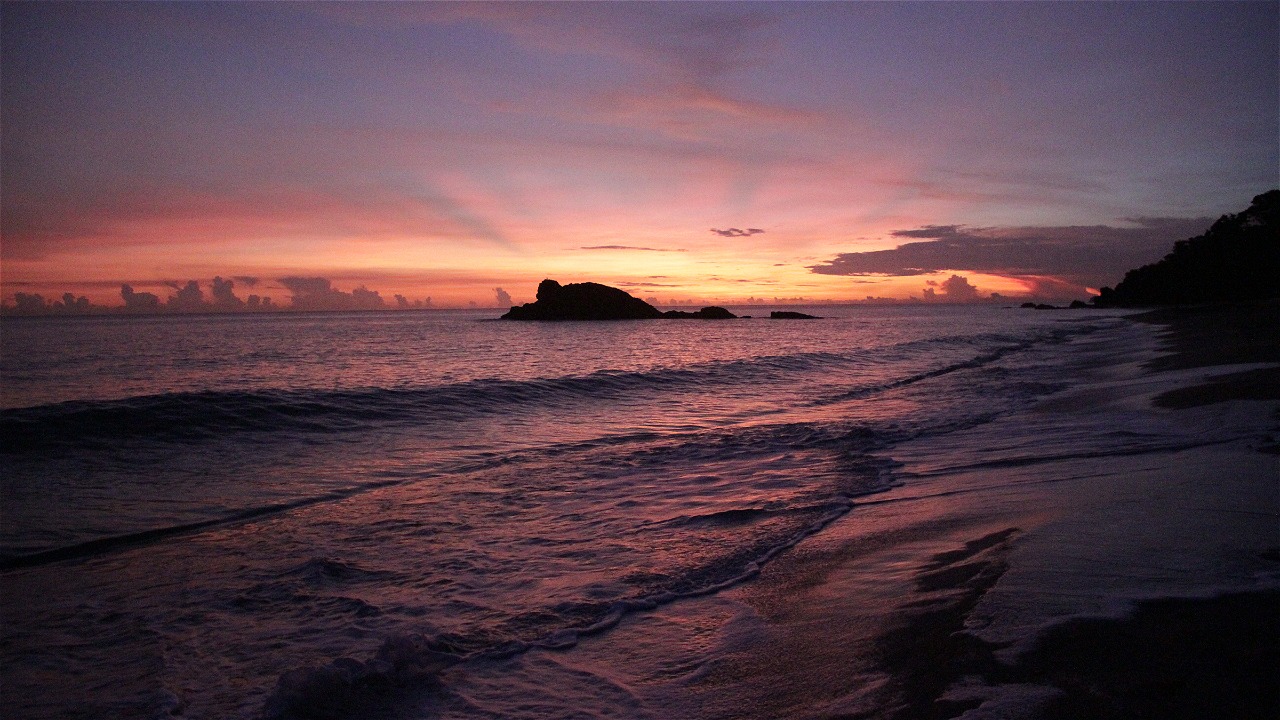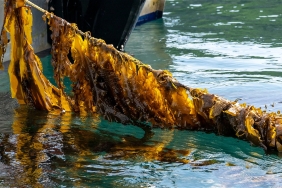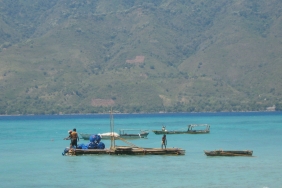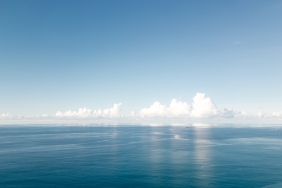LESSONS LEARNED FROM THE PROCESS OF ESTABLISHING ENVIRONMENTAL SERVICE FEES FOR KOON WATERS
By: Indarwati Aminuddin
Three years earlier, Habib Abdullah (Aquaculture and Fisheries Improvement Manager) together with Lida Pet Soede and Veda Santiadji (Coral Triangle Support Program Leader) oversaw the Marine Conservation Area (MCA) program with the Rights Based Management (RBM) tool in the Petuanan Kataloka area. The program is based on the fact that Koon waters are the spawning ground for high-value reef fish, especially grouper, sunu grouper, red snapper, tiger grouper, snapper, Titan triggerfish and bobara mata besar/bigeye trevally. Habib, Veda, Lida and the rest of WWF share the same view that protecting the 2,537.6 hectares of Koon waters from damage can maximize the size and abundance of reef fish, and ultimately make Koon waters a food source for 1.7 million Moluccans.
But the RBM mechanism is not a consequence-free, rights-based fisheries model. Ideally, RBM encourages supervision and control of fishing patterns, followed by regulation of market mechanisms. But when RBM is practiced, a series of consequences arise. First, from the fundamental aspect that the RBM mechanism allows positive law for violators to occur, meaning that if a fisherman violates then he is caught by the law, even though RBM itself emphasizes 'rights' for local residents. Many Petuanan Kataloka fishermen who are far from a scientific perspective see the reality that their rights and benefits cannot be enjoyed at this time. Secondly, Petuanan Kataloka's traditional, unwritten dimension regulates Ngam - the system of opening and closing the area during certain periods - and is carried out based on the King's orders. Breaking the king's rules has consequences in terms of social law; which is usually followed by physical law, sweeping the road, cleaning the garden, bringing fish to the king's family and so on. Politically, WWF was relieved when the Old King of Petuanan Kataloka, Muhamad Wattimena, agreed to sign a cooperation agreement to protect Koon waters from over-exploitation. The Old King will confront his people and establish the practice of closing the area in a modern way. He is assisted by his younger brother Raja Muda Anzhar Wattimena.
These two methods of protecting the area; MCA-RBM and Ngam appear similar, but differ in practice and consequences. In the Ngam practice, fishermen will get the result when the king orders the opening of the Ngam area, hurray...can take big fish!!! In MCA practice, there is no such thing as the area being opened, only that the area will be utilized, without reducing the value of its resources. If innocent fishermen ask, then when will it be opened? The answer is wallahualam.
In this MCA-RBM process, about 12,000 residents, representing 33 clans in Petuanan Kataloka are expected to participate in protecting Kataloka waters. As compensation for their commitment, WWF provides annual financial support of more than IDR 170 million which is used for various activities in Gorom and Grogos. Throughout the process of protecting the area, Raja Anzhar Wattimena recognized the terms he borrowed from WWF 'protection', 'conservation', 'preservation', 'for the sake of our children and grandchildren'. Grogos fishermen countered these words with the phrase, 'the area is closed by WWF'. In 2011-2012, furtive protests emerged from Grogos fishermen who were often found fishing in the protection zone.
Barnabas Wurlianty, Koon Project Coordinator, Coral Triangle said, "it's like being attacked by your own family." Barnabas is a soldier on the front lines. He goes back and forth between Ambon and Gorom, facing fishermen and confronting the young king of Petuanan Kataloka who is in a hurry with his many dreams. Barnabas' fatigue was not in the distance between Ambon and Kataloka (a total of 23 hours of land and sea travel), but in the pressure of the fishermen who began to ask questions, why after being protected they did not get anything? This is if you save money, the money cannot be taken when needed.
Habib is thinking of a strategy so that fishermen do not become enemies in the process of protecting the Koon waters. "They must get maximum benefits because they play a role in protecting the area from damage. We are thinking of opportunities to implement fisheries subsidies." Others, the Rp 170 million fund is not enough to replace the fishermen's 'rights and benefits', and is a small value to maintain the Koon water ecosystem. WWF, with all due respect, has limitations in continuously funding programs in Koon waters.
Customary Practice Versus Science Practice
It is unthinkable to benefit from tourism services. In 2010, a number of recreational boats have traveled the Banda-Raja Ampat, or Halmahera-Raja Ampat routes. Eddie, the manager of the recreational boat Pindito, had even started underwater activities in Koon waters 25 years earlier. He recalls that every time he dived, he was mesmerized by the dark waters, "fish...fish everywhere. This is the best site in the whole world," he recalled.
The family of the King of Petuanan Kataloka knew for certain that their waters held hidden treasures from many years ago. The sea treasures were taken periodically. "Namely when Ngam is opened. We usually get 200 kilograms of fish from local fishermen who fish in the surrounding area," wrote Raja Muda Anzhar Wattimena. But none of the Raja's family ever dived and saw the abundance of fish in Koon waters. Large fish were witnessed only when getting off the boat and or lying smelling of spices on the dining table. It was also a bit of a shock when they found out that cruise ships were taking their guests to dive in the Koon waters. Like the WWF, the King's family did not think of the opportunity to profit from these leisure boats.
Under considerable pressure, and dissatisfaction that the MCA was excluding Grogos, Gorom and Nukus fishermen. Lida said that recreational boats could be involved to finance the Koon water area. Habib and Veda discussed the procedures of the cruise ship financing model. "Well, tourists have to pay because they use Koon waters," Habib explained. He then took the initiative to find a consultant, at that time Ir Agus Sutiarso, a master of tourism. Agus was expected to be able to get the willingness of tourists' ability to pay when entering Koon waters.
In November 2013, in a meeting to strengthen ecotourism at the Mercure Sanur Hotel, Agus presented the results of his study, that local tourists are willing to pay Rp 150,000 per year and Rp 51,500 per visit. For international tourists is Rp 250,000 a year and Rp 51,500 per one-time visit. Meeting participants, mostly recreational boats, said they had no problem paying the diving fee, as the value of Rp 51,500 is relatively small. But if there are only 50 tourists a year, then doesn't the community only receive Rp 2,575,000? Is the ecosystem value of Koon waters equivalent to this small amount? Is it enough to compensate the rights and benefits of Kataloka residents?
The viceroy of Kataloka, Anzhar Wattimena, listened to the plan to benefit from tourism - to compensate for the conservation practices in place in Koon waters. He was excited, mainly because he saw Bali as a mecca for tourism and envisioned the Petuanan Kataloka region being visited by people with deep pockets, different skin tones and all the uniqueness of Kataloka land. He forgot that most cruise ships don't bring their guests down to the ground (in land), it is unlikely that tourists bring additional economic benefits to communities on land, and that Koon waters only have one dive site, not a major destination for recreational boats. Recreational boats travel from Halmahera to Raja Ampat-the ultimate destination. In other words...stopping by to get wet in Koon's waters. This means that if there is the slightest mismanagement, mis-financing, or damage to the Koon ecosystem, then cruise ships will say bye..bye Koon.
Tourism Movement
Koon, a small, empty, white-sand island with a beach no more than 200 meters wide, and 500 meters long. Hundreds of coconut trees grow in rows, managed by local residents. In a long customary record, the island is declared as the property of the king of Petuanan Katalola, and he, as the ruler, has the right to lend the land on the island to the people of Kataloka. Koon Island is adjacent to Grogos Island, an island inhabited by around 60 families. It can be said that the majority of Grogos residents are fishermen. They are the main users of Koon's waters.
Grogos Island is smaller than Gorom. The width of the island is no more than 30 meters and about 80 meters at the part where residents build wooden huts. Since tourism has been touted as an engine to compensate for conservation, the young king of Petuanan Kataloka has rushed to build a brick, tin-roofed beachfront resort at the tip of Grogos Island. At some point, seawater inundated the would-be resort, causing severe damage to the floor and half the walls. No tourists have come until now. Only a handful of people, including myself, have visited the prospective resort, stroking the weathered walls. The wife of Raja Muda Anzhar Wattimena said, "I warned him not to build anything...but he was stubborn." The investment was a waste.
Marco Kusumawijaya, architect and urban expert commented on the building politely. "Hmm ehm I think this idea is wonderful. But it seems we need to find a way to design it more nicely."
In 2013, Habib and Veda were quite optimistic about the idea of involving recreational boats to finance the protection of Koon's aquatic ecosystem, while revamping the MCA and RBM mechanisms so that they would not clash too sharply with the local values that the Kataloka community believed in. Habib encouraged this process to be handled by WWF-Indonesia's tourism team. From Gorom Island, with a crackle phone, the impatient young king calls regularly morning, afternoon, night, when should tourists pay? Like credit, the due date has arrived. It has been 3 years of the Koon MCA program and apart from the fact that fish are getting fatter in Koon waters, there is another fact; fishermen are restless. Pressure came from various parties, Raja, fishermen's groups and from the WWF-Indonesia team itself.
Throughout the year, discussions began to build. Various strategies were put forward. Lida proposed the development of a business plan for a learning and marine center on Koon Island. "We can submit the business plan to certain parties who are interested in investing in fisheries and biology research," she explains. The idea went nowhere, the investment was just too big. During the unloading period of the idea, Kataloka Patrol was asked to monitor the types, names of boats and the number of passengers diving in Koon waters. In 2013-2014, there were 21 boats that dropped off 233 tourists in Koon waters.
In the dry month of May 2014, the Old King of Petuanan Kataloka organized a folk party attended by nearly 300 residents, crowded next to the king's house. The king took the opportunity to invite me to stand before his people and tell them about the WWF program. What should I tell them? That the program benefits the people? That their future is better? I trembled and uttered a sentence that did not please the king and his people. "Let's...work together to develop Kataloka and the waters of Koon." The party closed with a mass dance, everyone enjoyed themselves, except me. It felt so depressing to have appealed to the new order style.
Payment for Environmental Services
PES is a scheme whereby users of a particular area pay to protect the area, or treat the area in a sustainable manner. In Koon waters, the main users are currently fishermen, followed by recreational boats. PES mechanisms depend on the 'market'. In some instances, such as financing clean water environmental services, and forestry stewardship, this mechanism is fairly effective. But for financing water-related environmental services, this mechanism requires extra work. First; this financing requires the support of strict monitoring of other water users, namely fishermen. With the high mobility of the sea and the lack of supervision at sea, the element of insecurity looms over this mechanism. Secondly, this financing includes the aspect of fair and equal sharing for the 'lost earnings' group. By customary standards, where all policies originate from the King's authority, the opportunity to make all parties happy is highly dependent on the wisdom of the king of Petuanan Kataloka.
The customary characteristics and market approach in Kataloka Waters allow 'private payment', where the Kataloka customary party has the right to benefit from the service of Kataloka waters that have been guarded by dealing with other parties who utilize Kataloka waters. This system is different from the other two PES systems, namely first; public involvement, where the government pays for the services of the resources it uses, and second; public private payment, where both the government and the private sector pay for the environmental services they utilize. In terms of spatiality, Kataloka's PES is also relatively small, which is only on the aspect of 'catch' and local location in the waters, not across national and international administrative boundaries.
In the context of Kataloka PES, four players are actively involved, namely WWF-PT SEI-Petuanan Katalola in this case the Leawana indigenous community and recreational boats, and the financing scheme is carried out with the concept of one to one, the user finances directly to the seller, and with the purpose of financing proceeds being used to conserve Kataloka waters (input-based-payments).
These four players have their own questions. Buyers of recreational boats for example ;questioning their ability to pay in the long run, they may move locations depending on the direction of the market, sellers of Petuanan Kataloka with high ambitions for revenue are thinking about other aspects that can be sold from Koon waters,
In addition to PES in Koon, WWF also successfully supported the implementation of PES in Lombok. In cooperation with the Government, community groups and international government agencies, the PES mechanism was implemented with the main object; water supply. Since July 2007, the Lombok PES scheme was adopted by the local government. This PES scheme has a real economic impact on upstream communities that maintain the ecosystem on Mount Rinjani, where the ecosystem is able to maintain water supply.
Phase of Kataloka Waters Environmental Services Financing Process
In Kataloka, the PES initiation process started in May 2014. A number of consolidation meetings, consultations and open discussions to discuss financing strategies for Koon waters took place with stakeholders. Not all meetings ended happily. In 2015, the coordinator of the Indonesian recreational boats (Jangkar), Suryani Mile Doucet emphasized that they were willing to help manage the area with the aim of a better ecosystem. A healthy ecosystem is like a plate with delicious and healthy food, the connoisseur wants to maintain it.
In 2015, an agreement on a reasonable amount was agreed between the parties, in November 2015 (see table below), albeit with a number of demands: Koon waters must have more than 1 dive site. Otherwise, recreational boats may shift to other sites.
International
Rp 100,000/3 days
Rp 250,000/year
Domestic
Rp 50,000/3 days
Rp 150,000/year
Petuanan Kataloka assured the parties that the use of PES funds is intended for ecosystem activities (monitoring and patrolling), supporting local customs and culture through education and various other forms of activities.
Still in the same month, the parties then agreed to sign the implementation of payment for environmental services. In March 2016, a socialization of PES payment procedures was conducted and PT SEI was introduced as the intermediaries of indigenous communities and recreational vessels. The East Seram Regency government was present. The Koon water area has brought the parties to accept the fact that their nature has invited various foreign guests to come, enjoy the underwater beauty of the Koon waters and have the expectation that the beauty must be maintained...there..in the Koon sea.
Not more than two weeks after the socialization process, four recreational boats made payments. Relieved? Yes, but the work is not yet done, the real challenge now awaits, making the PES funds equal in value to the ecosystem services Koon waters have served humans, and making the funds from PES equal in value to the 'losses' fishermen have incurred.





